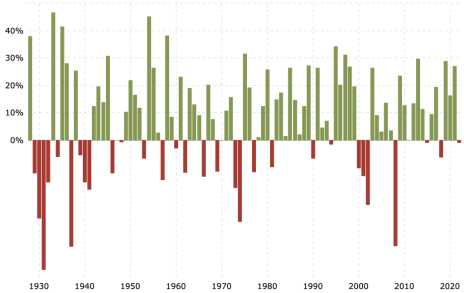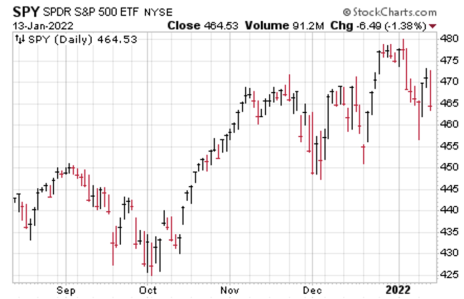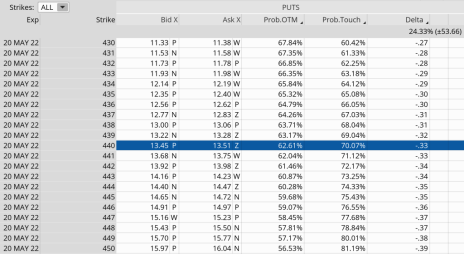How can I protect returns without having to sell my positions?
It’s the hot question being sent my way right now.
And it makes perfect sense when you consider just how far the S&P 500 has come over the past three years.
- 2021 – 26.89%
- 2020 – 16.26%
- 2019 – 28.88%
[text_ad use_post='261460']
So, after three consecutive years of incredible market returns it’s okay to think that another year of near 27% returns might not be in the cards.
Source: MacroTrends
Just realize no one has a crystal ball…no one. You can clearly see in the chart above that there have been periods where the market has had extended gains. But if you are like me and managing a few conservative portfolios, a collar might be an options strategy worth considering.
The Protective Collar – The Basics
A protective collar’s goal is to preserve hard-earned capital, while simultaneously allowing a position to continue making profits, albeit limited.
Unfortunately, greed deters individual investors from using collars. Hedge funds and even large institutional managers frequently use collars, so why aren’t most individual investors?
It’s because most investors don’t realize that collars not only protect their unrealized profits, they also allow you to hold a position that you don’t want to sell but want some downside protection for just in case the stock takes a fall. Think earnings surprises or if you own a stock that pays a healthy dividend that you want to keep holding. Or maybe investors don’t realize it is one of the cheapest, yet most effective ways to reduce risk.
It doesn’t really matter the reason; it only matters that you start using this strategy to keep risk in hand. Because the most important aspect to successful, long-term investing is a disciplined approach to risk management. Without it, even the best strategies are inevitably doomed.
A collar options strategy requires an investor who already owns at least 100 shares of a stock to purchase an out-of-the-money put option and sell an out-of-the-money call option.
Think of it as a covered call coupled with a long put.
- Long Stock (at least 100 shares)
- Sell call option to finance the purchase of the protective put
- Buy put option to hedge downside risk
*Collar Option Strategy: long stock + out-of-the-money long put + out-of-the-money short call
That’s right, you read bullet point two correctly. You can actually finance most of your protection, so the cost of a collar is limited, if not free. Again, this is why intelligent investors and professional traders use collars habitually.
The Trade – An Example Using the S&P 500 ETF (SPY)
Let’s say you own a basket of ETFs and want to protect your return going forward—or at least produce a bit of income from your positions while simultaneously hedging against a pullback.
Yes, you may have to forgo some upside profits in the process if your position rockets higher, but you also have the reassurance that your profits are being protected over the short to intermediate term. And again, you are still able to make a decent profit if the ETF continues to trend higher.
For example, let’s say we own 100 shares of the SPDR S&P 500 ETF (SPY) and would like to protect our return going forward. We still want to hold the position and participate in further upside. But we also realize that the ETF has had an incredible run and want some downside protection, specifically over the short to intermediate term.
The ETF is currently trading just off all-time highs at 464.53.
- With SPY currently trading for 464.53, we want to sell an out-of-the-money call as our first step in using a collar option strategy.
I typically look for a call that has roughly 30-60 days left until expiration. So, to keep things simple, I am going with the March options that are due to expire in 64 days.
I don’t want to sell calls that are too far out-of-the-money because I want to bring in a decent amount of premium to cover most, if not all, of the protective put I’m going to buy. But of course, ultimately the choice depends on your personal agenda.
As a result, let’s say I try to sell a call with a delta somewhere around .40. The March 472 call option with a delta of .40 fits the bill. We can sell the 472 call option in March for $8.93, or $893 per call. We can now use the $893 from the call sold to help finance the put contract needed to achieve our goal of protecting returns.
2. The next and final step is to find an appropriate protective put to purchase. There are many different ways to approach this step, mostly centered around which expiration cycle to use. Should we go out 30 days in expiration? 60 days? 120 days? It really is up to you to decide.
I prefer to going out as far as I can without paying too much for my protective put. In this case, I want to protect the position from a decline of 5% or greater.
I’m going to go out to the May expiration cycle with 127 days left until expiration. I plan on buying the 440 puts for roughly $13.45, or $1,345 per put contract.
This means that almost the entire cost of the May 440 puts will be nearly covered by selling the March 472 calls. Because remember, you can sell more calls at March expiration.
Total Initial Cost: May 440 puts ($1,345) – March 472 calls ($893) = $452 debit
Again, we can add to our return by selling more calls for April or May expiration while still maintaining protection through May 20, 2022.
So, as it stands our upside return is limited to 472 over the next 64 days. If SPY pushes above 472 per share at May expiration, our ETF would be called away. Basically, you would lock in any capital gains up to the price of 472. With SPY currently trading for roughly 464.53, you would tack an additional $7.47, or 1.6% to your overall return.
But the key reason to use the strategy is not about making additional returns, it’s about protecting profits. And through using a collar options strategy, in this instance, you are protected if SPY falls 5% lower, or below 440 (where we purchased our put option).
Collars limit your risk at an incredibly low cost and allow you to participate in further, albeit limited, upside profit potential. The trade above would be a conservative use of the strategy as the parameters are fairly tight. As always, you have the ability to expand the parameters of the trade to fit your risk tolerance.
Again, if you have any questions, please feel free to email me or post your question in the comments section below. And don’t forget to sign up for my Free Newsletter for education, research and trade ideas.





